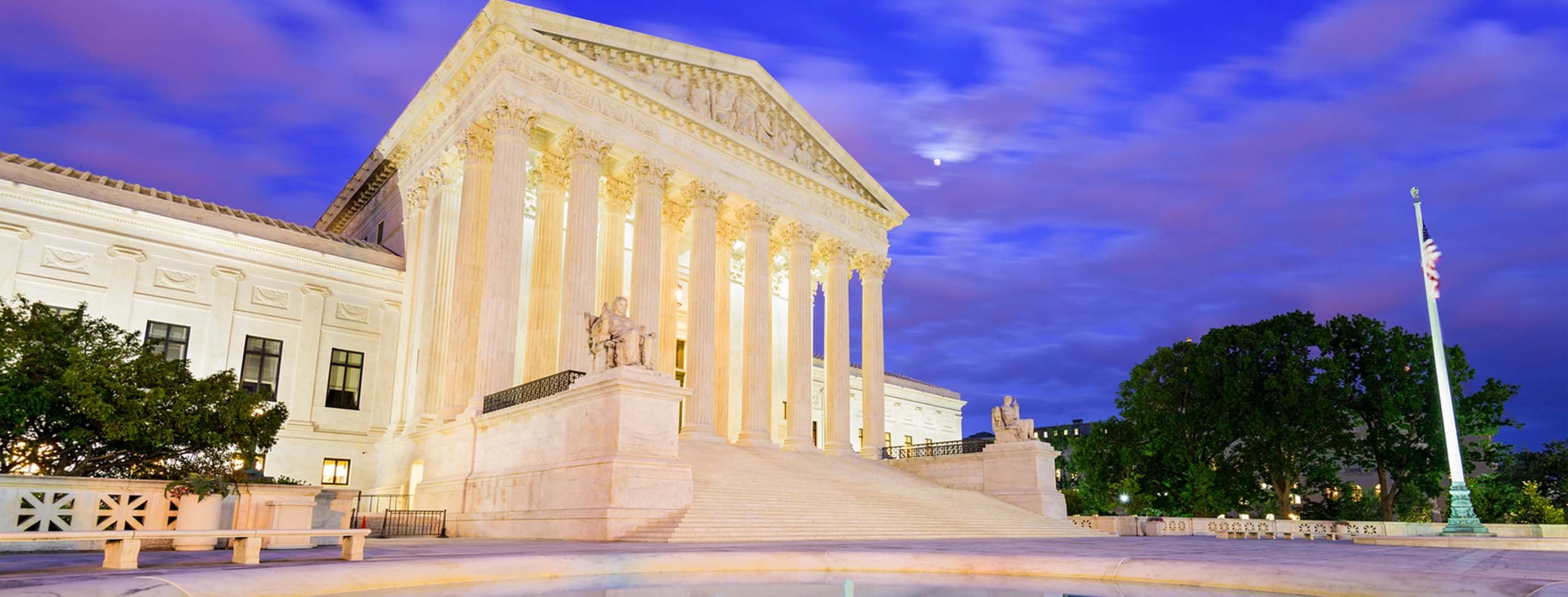
28 June 2024 • 12 minute read
Chevron overruled: In Loper Bright v. Raimondo, the Supreme Court reshapes the regulatory landscape
In a much-anticipated decision, the Supreme Court has overruled the Chevron deference doctrine, an administrative law precedent that provided the framework for judicial review of federal agencies’ formal interpretations of statutes for the past 40 years.
The Supreme Court’s ruling in the consolidated cases, Loper Bright Enterprises v. Raimondo and Relentless, Inc v. Department of Commerce, (“Loper Bright”), can be expected to have profound implications for federal agencies and those subject to federal regulation – which is to say, nearly everyone in the US.
Under Chevron, a reviewing court was required to defer to a federal agency’s reasonable interpretation of ambiguity in a statute administrated by the agency – a standard that led lower federal courts to rule for the government in the majority of challenges to agency rules and regulations.
In the June 28, 2024 Loper Bright decision, a 6-3 Supreme Court majority abolished the Chevron doctrine. The Court held that, under the Administrative Procedure Act, courts must “exercise independent judgment in determining the meaning of statutory provisions,” even ambiguous ones.
The Court’s ruling has major implications for the operations of all three branches of government and for regulated entities. Among other things, this blockbuster ruling:
- Charges courts with supplying the interpretation of ambiguous statutory provisions, even where technical and scientific expertise may be implicated;
- Increases the likelihood of success of those challenging federal regulations;
- Limits executive agencies’ ability to fill gaps in the laws or to address situations not expressly anticipated by Congress, and may cause agencies to proceed more cautiously and narrowly in adopting regulations; and
- Places pressure on Congress to legislate with greater specificity (or at least to make express delegations of interpretative authority, where permissible).
Reduced judicial deference to agency interpretations may also increase regulatory uncertainty and limit the ability of businesses to confidently act in reliance on agency pronouncements – particularly in the near term as both agencies and courts adjust to the post-Chevron legal landscape.
I. BACKGROUND AND CONTEXT
The Chevron deference doctrine was articulated by Justice Stevens in Chevron USA, Inc. v. Natural Resources Defense Council, 467 U.S. 837 (1984), a case involving a challenge to EPA regulations interpreting a term in the federal Clean Air Act. The Supreme Court set out a two-step test for courts reviewing an agency’s construction of a statute it administers.
- At step one, the court asks “whether Congress has directly spoken to the precise question at issue.” If the meaning of the statute is “unambiguously expressed,” then “that is the end of the matter” because the agency and court must adhere to that.
- At step two, “if the statute is silent or ambiguous with respect to the specific issue,” the court then asks “whether the agency's answer is based on a permissible construction of the statute.”
It is the second step that became known as “Chevron deference,” as it called for courts to resist “simply impos[ing] their own construction of the statute” and instead to defer to an agency’s reasonable construction of a statute when the statute failed to clearly express Congress’s intent.
Over the last 40 years, Chevron deference became a bedrock doctrine of administrative law, with federal district courts and appellate courts applying the test in tens of thousands of cases. And application of the test strongly favored agency interpretations. Studies have estimated that the agency prevails in more than three-quarters of such cases decided by federal courts of appeals and that proportion may be higher in federal district courts.
As a result, under Chevron, executive branch agencies have played a central (and seemingly ever-expanding) role in interpreting federal regulatory statutes, which sometimes purposefully leave gaps for agencies to fill or simply do not anticipate all of the issues that may arise in their implementation and enforcement.
Whether vesting such judgments and power in federal agencies is appropriate as a matter of law, policy, political accountability, or practicality has been a matter of continuing debate. In the last decade, there have been increasing calls to limit or overrule the Chevron standard in favor of more stringent judicial review.
Last year, the Court granted certiorari to consider two circuit court decisions that applied the Chevron methodology to uphold a somewhat obscure National Marine Fisheries Service regulation. The regulation at issue requires fishing vessel owners, in some circumstances, to pay for an onboard observer to monitor compliance with federal fisheries regulations. In the lead case, Loper Bright, the D.C. Circuit found the underlying statute, the Magnuson-Stevens Act, silent on the question of whether vessel owners could be required to pay for a monitor. The court proceeded to Chevron step two where it deferred to the agency’s interpretation, which it found to be reasonable.
The Supreme Court’s framing of the question presented signaled that the Court would look beyond the fishing vessel rules to decide the fate of the Chevron doctrine: “Whether the Court should overrule Chevron or at least clarify that statutory silence . . . does not constitute an ambiguity requiring deference to the agency.”
II. THE SUPREME COURT DECISION
Now, the Supreme Court’s ruling in Loper Bright has resolved the question presented in no uncertain terms: “Chevron is overruled.”
Chief Justice Roberts, writing for the majority, found that the Administrative Procedure Act (“APA”) requires that result when it commands that courts decide “all relevant questions of law” when reviewing an agency action.
According to the Court, there is a “best reading” of each statute, and it is the “one the court, after applying all relevant interpretative tools, concludes is best.” The one exception is when “a particular statute delegates authority to an agency consistent with constitutional limits,” but even then “courts must respect the delegation, while ensuring that the agency acts within it.”
The Court concluded that Chevron deference was an erroneous judicial invention that should not be protected by stare decisis. The Court explained, however, that its overruling of Chevron deference does not apply retrospectively: Cases that were decided in reliance on the overruled test, remain good law entitled to statutory stare decisis “despite [the Court’s] change in interpretive methodology.”
While the majority opinion is grounded in the statutory requirements imposed on courts by the APA, a concurring opinion by Justice Thomas asserted that the same result is also constitutionally required based on separation-of-powers principles.
In another concurrence, Justice Gorsuch wrote that the ruling reflects “the proper application of the doctrine of stare decisis,” “return[ing] judges to interpretative rules that have guided federal courts since the Nation’s founding.”
In a dissenting opinion, Justice Kagan, joined by Justice Sotomayor and Justice Jackson, observed that regulatory laws often contain ambiguities and gaps, and that agencies are more likely than courts to have the subject-matter expertise necessary to determine how to read those statutes. The dissent expressed deep concern that the ruling gives the judiciary “exclusive power over every open issue—no matter how expertise-driven or policy-laden—involving the meaning of regulatory law.”
III. IMPLICATIONS FOR FUTURE LITIGATION AND THE REGULATORY LANDSCAPE
A. Post-Chevron Judicial Review
Opportunities for litigants?
Loper Bright promises to create opportunities for those seeking to challenge regulations they believe are unreasonable, unsound, or inconsistent with congressional direction or intent. Regulatory statutes are frequently silent or unclear on issues critical to implementation and enforcement. In those cases, absent interpretive authority clearly and lawfully delegated to the agency, challengers will no longer have to overcome automatic deference to an agency’s interpretation. Rather, litigants’ task will be to persuade the reviewing court that the agency did not apply the “best reading” of the underlying statute.
How will federal courts determine the “best reading” of statutes?
Statutory ambiguity, gaps, and unanticipated developments are inevitable. Going forward, how will courts resolve questions about the “best reading” of a federal statute?
Loper Bright makes clear the power and responsibility for determining the best interpretation is the province of the courts, who should use “all relevant interpretive tools” at their disposal (presumably referring to interpretive canons and other tools of statutory construction). Rejecting Chevron’s precept that there could be permissible interpretations that are not what the court would have reached, the majority concluded “[i]n the business of statutory interpretation, if it is not the best, it is not permissible.”
Agencies’ power to persuade
While Loper Bright forecloses the automatic deference afforded to agencies under Step Two of the Chevron analysis, it does not preclude courts from considering the persuasive power of an agency’s views when determining the “best reading” of a statute.
The majority opinion cites approvingly to Skidmore v. Swift, 323 U.S. 134 (1944). Under Skidmore (which pre-dates the enactment of the APA), courts give no presumptive weight to agency interpretations but consider the agency’s “power to persuade.” Factors a court may consider in determining the persuasiveness of an agency’s interpretation include the thoroughness of the agency’s consideration, the validity of its reasoning, and its consistency with earlier and later pronouncements.
This has long been the approach federal courts have taken to reviewing informal, non-binding interpretations issued by agencies, and we may see lower courts extending the Skidmore approach to agency regulations. The application of Skidmore may allow courts to continue to recognize, where appropriate, the persuasive power of an agency’s expertise and experience.
Application of the major questions doctrine and non-delegation doctrine
Loper Bright acknowledges that a statute may contain an express delegation of authority to an agency to interpret and implement particular provisions. According to the ruling, courts should defer to such delegations, provided that the agency is properly acting within the scope of its lawful delegation.
Both the major questions doctrine and the non-delegation doctrine limit the scope of delegations, which is likely to figure prominently in future litigation.
The major questions doctrine prevents agencies from undertaking regulation with “vast economic and political significance” unless Congress has in clear terms expressly delegated that power to the agency. See, eg, West Virginia v. EPA, 597 U.S. 697 (2022).
The non-delegation doctrine enforces the constitutional separation of powers between the legislative and executive branches by imposing limits on what lawmaking powers Congress may delegate to administrative agencies (Congress must provide agencies with an “intelligible principle” upon which to base regulations). The doctrine has rarely been applied by federal courts in recent years, but may be a basis, going forward, by which courts seek to limit excessive delegation of legislative power to executive branch agencies.
The scope and contours of these doctrines are likely to be subjects of future litigation.
B. Post-Chevron Regulatory Landscape
More uncertainty for regulated entities?
Regulatory certainty and stability are important to many companies in developing strategic plans, investing, mitigating risks, and other important business decisions. To varying extents, businesses rely on agency regulations to establish standards governing their business activities and delineate how federal laws will be enforced in specific contexts and circumstances. The Chevron deference doctrine provided some assurance to regulated entities that a reviewing court would likely uphold an agency’s reasonable construction of a statute the agency was charged with implementing.
One result of the elimination of Chevron deference, at least initially, likely will be heightened uncertainty regarding the validity of agency regulations. How a reviewing court will rule, absent an effective presumption of agency correctness, may be difficult to predict. And the results on review may vary with the court or judge when the question boils down to “what is the best construction or application of the statute?”
The Supreme Court has overruled Chevron, but it has not provided clear or specific direction about what comes next. What approach or standard should lower courts apply to resolve uncertainty that persists after the traditional tools of statutory construction have been applied?
Until that question is resolved, federal courts of appeals and district courts may apply different approaches and analyses, fostering uncertainty – and possibly increased forum shopping – until a consistent approach emerges. At a minimum, it fair to expect a significant transition period as lower courts determine the methods they will rely upon.
Significant implications for all three branches
Loper Bright will have consequences for the de facto roles and operations of all three branches of the federal government.
- Perhaps most clearly, the decision shifts power and responsibility for interpreting federal statutes from the executive to the judicial branch. But, Marbury v. Madison notwithstanding, significant questions are likely to arise as to courts’ capacity to determine “what the law is” in specialized areas of the law, absent clear and specific congressional direction.
- In a post-Chevron environment, executive agencies may be more circumspect in adopting regulations, filling legislative gaps, and taking regulatory actions to address situations and developments that Congress did not anticipate or address.
- Finally, Loper Bright arguably calls for greater clarity and specificity from Congress in the statutes it enacts. This may be a tall order for Congress as it is presently constituted and resourced—and may create heightened demand for input from outside experts. At least in some instances, the ruling may impel more and clearer congressional directions to federal agencies regarding how statutes are to be implemented. And at a minimum, it may prompt more explicit delegations of interpretive authority to agencies with subject-matter expertise when Congress wants to ensure that agencies are empowered to address particular gaps in the laws.
MORE TO COME
The Supreme Court’s watershed decision in Loper Bright raises many agency-specific and industry- specific questions.
The DLA Piper topic page, “End of Chevron deference and its implications,” provides insights on the expected effect of Loper Bright in particular areas of law, including health care, food and drug, environmental, tax, securities, privacy, and telecommunications regulations.
Please watch for upcoming alerts focusing on the expected effect of Loper Bright in particular areas of law, including health care, food and drug, environmental, tax, securities, privacy, and telecommunications regulations.
Please contact Samantha Chaifetz, Stan Panikowski, Peter Karanjia, Paul Hemmersbaugh, Ilana Eisenstein, or your usual DLA Piper contact to learn more about DLA Piper’s Appellate and Administrative Law practices.
.jpg?h=1150&iar=0&w=2560)

